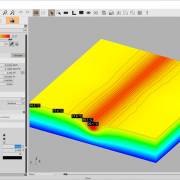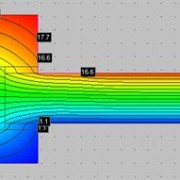We’re pleased to announce one of the biggest updates on our thermal simulation software! Please visit Mold Simulator and Frame Simulator pages for more information.
We’re pleased to announce the release of update 3.0.4 for Mold Simulator and Frame Simulator, our thermal bridge analysis and window transmittance computation softwares. Please go to their respective pages to get the latest viewer version.
Here you are the list of changes:
– fRsi sample label;
– segment opacity;
– ability to select vertices by one or more material names;
– lambda value on library materials’ name;
– .csv files importing improvement;
– continuous facade Utj – PSIj computation;
– boundary library access from Bridge Generator;
– psi contributions separation when using three boundary conditions;
– various bug fixes.
We’ve just released update 3.0.2 for Mold Simulator and Frame Simulator, our thermal bridge analysis and window transmittance computation softwares. Please go to their respective pages to get the latest viewer version.
Frame Simulator is our flagship software for window transmittance (EN ISO 10077-2) computation. After two years of development, we’re pleased to announce Frame Simulator 3; for more information please go to Frame Simulator page.
We’re pleased to announce the release of update 2.1.7 for both Frame Simulator, our window transmittance simulator, and Mold Simulator, our thermal bridge software. This is a maintainance release, with a some bug fixes. You can get the latest viewer versions here:
Frame Simulator | Windows Transmittance
Mold Simulator | Thermal Bridges
We’re pleased to announce that Frame Simulator, our windows transmittance calculation software, 2.1.6 is out. We’ve solved several bugs; you can download the viewer version here.
This is a maintenance release with a bunch of bug fixes. Please go to Frame Simulator page to download the updated viewer version.
We are pleased to announce that Frame Simualtor, our window thermal transmittance simulator (for Windows and Mac OSX), version 2.1.2 is out! Here you are the list of major changes:
- insulation panel’s cross element now considers the real width;
- border and minimum with options for table tags;
- various bug fixes.
The new viewer can be downloaded at Frame Simulator | Window Transmittance.
Frame Simualtor, our window transmittance simulator (for Windows and Mac OSX) version 2.0.9 is out! Here you are the list of major changes:
- settings file can be saved to a custom folder;
- conditional labels;
- improved printed viewports;
- import/export more than one texture a time;
- views window minimized at run time;
- various bug fixes.
The new viewer can be downloaded at Frame Simulator | Window Transmittance.
This is the second part of a tutorial about window transmittance computation using Frame Simulator, our FEM simulator available for Windows and Mac OS X. For the first part, please see Window Transmittance – part 1.
In this tutorial we’ll use the following abbreviations:
- LMB = left mouse button click;
- MMB = middle mouse button click;
- RMB = right mouse button click.
Borders definition
Please click “Boundary” tab and select “Internal”; now click on ![]() button and LMB over one of the lines in contact with intern environment. Similarly, select “External” please click
button and LMB over one of the lines in contact with intern environment. Similarly, select “External” please click ![]() button and LMB over one of the lines in contact with extern environment.
button and LMB over one of the lines in contact with extern environment.
In current project, borders should look in this way:

Moreover, please make sure to have selected ![]() flow direction in “Lines” tab.
flow direction in “Lines” tab.
Simulation
Please click “Simulation” tab and wait that the software performs all the necessary computations. At this point, you can select different types of view: heat flow, temperature, isotherms, etc.
The values required by ISO 10077-2 standard, window transmittance and Lf2D, are shown in “Results” table.

As you have seen, the way to window transmittance following ISO 10077-2 standard is extremely easy with Frame Simulator. We’re planning some more tutorials and articles, so stay tuned!


